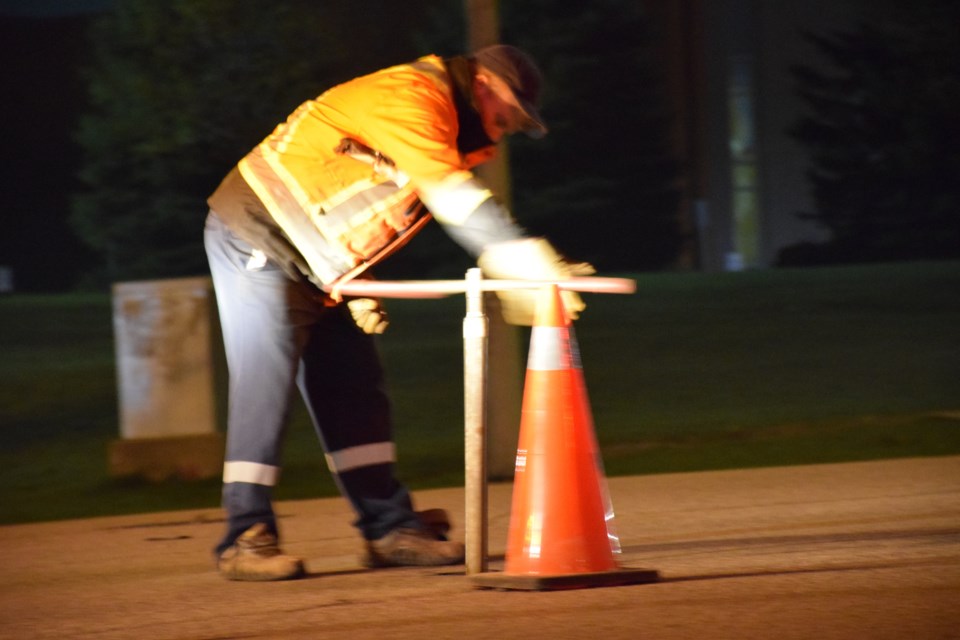Guelph residents expect crystal clear water to flow into their homes and businesses. They don’t want brown water in their drinking cups or washing machines, for obvious reasons.
To that end, the City of Guelph undertakes spring swabbing and flushing operations to get any accumulated mineral deposits out of the pipes.
Guelph’s water supply is from the ground, and it contains fine particulate minerals that settle in the water mains over time. They need to be flushed or pushed out each year.
A carefully planned schedule of swabbing, advancing from neighbourhood to neighbourhood across the city, started on Apr. 17 and continues to May 4. The flushing part is scheduled to start on May 8. Flushing is generally carried out on older metal water mains, where swabbing is less effective or not possible.
Kier Taylor, supervisor of distribution and metering in Guelph’s water services department, along with Laura Mousseau, a city communications officer, took GuelphToday on a nighttime observation of the swabbing process. It may sound uneventful, but it was not without excitement and fascination.
City contractor Ontario Clean Water Agency, lead on the site by Dave Sharp, carried out the 10 p.m. to 5 a.m. operation in the Clairfields neighbourhood in the southwest corner of the city. Ontario Clean Water Agency conducts the same kind of work throughout Ontario.
Sharp said he has seen all kinds of water pipe situations, including ones in which municipal water systems hadn’t been cleaned for decades, with quite unsightly results, and others where the mineralization and corrosion was so pronounced that pipes burst when under pressure of cleaning.
Taylor explained that Clairfields, being a newer city neighbourhood, has PVC water pipes. While they don’t corrode and become constricted with deposits like older metal piping, minerals nevertheless adhere to the walls and settle at the bottom of the synthetic plastic piping.
Swabbing essentially pushes all the minerals out of the pipes, ensuring the water is clear, the way people like it.
At about 10:30 p.m., Sharp began the process. Several dense, spongy swabs, each about the size of a five-gallon pail and shaped somewhat like a mortar shell, were set out on the boulevard at the intersection of Clairfield Drive W. and Clair Road. It would take about 14 of these swabs to completely clean the water main in that specific section.
City workers shut off the water to the main, which allowed Sharp’s pumper truck to direct the flow of water. One at a time, Sharp stuffed the swabs into a receptacle at the back of the truck, at five minute intervals. It took a lot of effort to work them down into the hole.
He then bolted on the lid and turned on the water, which pushed the swab into the water main at a speed of one metre per second. At that rate it would take 20 to 25 minutes for a swab to scrub the maze of pipe and emerge at the end point.
Taylor and Mousseau then lead the way to Gosling Gardens, a few blocks away on the east side of the Clairfield Neighbourhood. At a location near the entrance to Gosling Gardens Park, water gushed from a thick hose connected to a hydrant.
After a few minutes, the water began to darken to the tone of Coca Cola, a sign that the swab was pushing the brown and black minerals out of the main.
The water passes over a number of dechlorination pucks as it flows to the storm sewer. Mousseau explained the measure prevents chlorine from getting into the storm water system, which flows back untreated into local rivers. The pucks dechlorinate the water.
With a belch and a buckle, the first swab finally spewed out of the pipe. It had gone from pure white to mud-brown in transit. Swabs would be forced through the water main until the water at the other end was perfectly clear.
The swabs work effectively, Taylor said, because they are oversized relative to the size of the pipe, and that allows them to fully scour the walls and remove any loose iron and manganese deposition.
He said flushing is a similar process, only it used high velocity water, not swabs, as the scouring force.
The results of both process are the same – cool, clear water.
